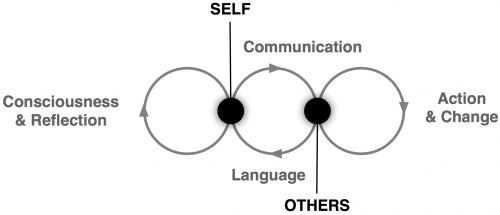18-25: moving from Becoming to Being
I got to talking to one of my favorite coffee shop girls at my favorite coffee shop today. She’s 23 and just graduated from College and living with her younger sister, 21, and we were talking about differences in age. In my day job I spend a lot of time interacting with people in the 18 - 25 year range—and though I just left range a few months ago myself—also spend a lot of time with those ages in my personal time as well.
The 18-25 age range isn’t so much generationally awkward—though you might hear otherwise—as externally/socially awkward. In the social service sector, there is at least an order of magnitude decrease in support service spending for individuals once they reach 18. Even in our infantilized American society, there is a marked difference in how people are treated once they reach adulthood. It’s surprising that, despite the near-general view that our Education system and family/social support networks (learning towards one or the other depending on your politics) do not prepare young people do be adults_,_ that they are still expected to act like them—whatever adulthood means for you, that is.
Off the soapbox…
In my AmeriCorps*VISTA orientation, I give a presentation—a charismatic lecture—that I’ve developed entitled** Advocate for Yourself**. (I am most proud of myself that it does not once include the word “Professionalism”, other than in derogatory aside.) The presentation is geared towards incoming VISTA members, who’s next 12 months of highs and lows is pretty well mapped out. Because I can’t guarantee that narrow track of experience for you, dear reader, I’ll do my best for the setup here:
The difficulties of the 18-25 year old range have to do with what I call moving from Becoming to Being. As a young person, most of your energy is put towards becoming a functioning member of society. But once you get there, well, you’re there—and while it’s liberating, it’s a lot harder to maintain… mostly because it’s so liberating.
Things that used to be provided you must now seek out:
-
Cuing: There aren’t as many people who will tell you when you’re doing something wrong, or help you do the correct thing. It’s simply no longer anyone’s job; a job usually coinciding with Mandated Reporter. You’re less likely for someone to tell you “get a job”, “you’re eating what?” or “you should have a doctor look at that”. Even regarding social norms, you’re more likely to be fired, dumped, or not have your calls returned than be confronted about them. And as time goes on, you’re less likely to have a diverse social network—social networks, unlike your high school, are self-selecting—who can clue you in. At least maybe until your own kids reach maturity—though at this point you’ll probably be living in such an echo chamber that you’ll think it’s them who need adjusting.
-
Paths: You have to make your own. When I went to school, there was one path: college. After that (and if not that) it all got a little fuzzy. And if you didn’t go to college—or were never planning on it— this struck you a whole lot earlier. There isn’t anyone setting goals for you anymore: it’s up to you to figure out where you want to go, and how you want to get there. There are a lot less options for filling in the blanks in personal and professional development too. Compare the number of Adult Ed classes that are available to the number of Youth Extracurriculars—it’s depressing.
-
Reinvention:
Remember ever starting your first day at a new school? Planning what you’d wear, the stories you’d tell, the new persona you’d create so they’d think you’re cooler than you were before. Not so easy anymore; it doesn’t come on a regular schedule of every 3-5 years. There is a whole lot more baggage you’re carrying around that makes it that much harder to form as clean a slate as possible. That makes it a lot harder to put some distance between your boneheadedness then and your (slightly-) less boneheadness now.
Reading over those, I didn’t mean for them to be so depressing (and caricatured), but it’s something to be mindful of and work against: putting yourself out there, setting personal and professional goals (and revisiting them from time to time), keeping yourself as fluid as possible (as much as Wealth Bondage allows), and having a good mentor, therapist and/org priest with whom you can talk stuff through.
